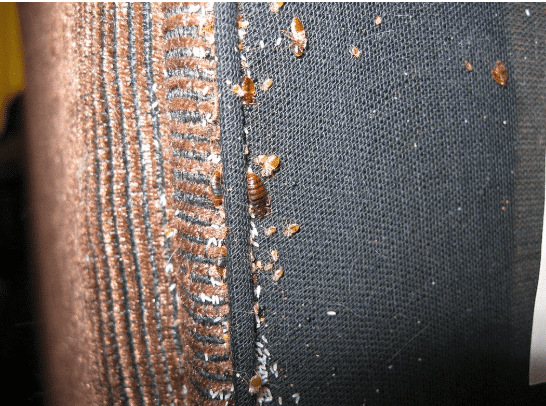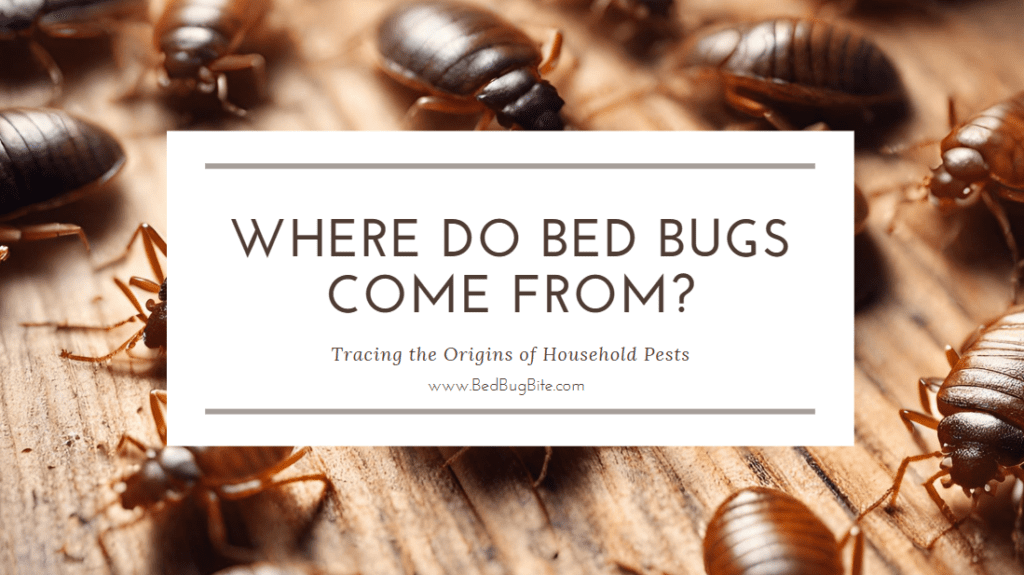Introduction: The Persistent Pests
Tracing the Origins of Household Pests. Bed bugs, those tiny, elusive pests that have been a bane for sleepers across the globe. Are often shrouded in mystery, especially regarding their origins. Unraveling the enigma of where these pests come from is crucial not only for curbing their spread but also for effectively combating them in our homes and lives. In this comprehensive exploration, we delve into the fascinating yet disconcerting world of bed bugs. Shedding light on their historical journey and modern prevalence. These creatures, known scientifically as Cimex lectularius, have not only coexisted with humans for centuries but have also thrived in our living spaces due to their unique adaptations. Understanding their origin and spread is a vital step in managing and preventing infestations. …For more Bed Bug Information, click here!
To further enhance your knowledge about these persistent pests, the Environmental Protection Agency (EPA) offers a wealth of information on bed bug identification, life cycle, and behavior. Their insights EPA’s Bed Bug Resources provide a foundational understanding that complements our in-depth exploration. By coupling our expertise with reliable resources, we aim to equip you with the necessary tools to tackle these bug challenges confidently and effectively.
In this article, you will discover not just the roots of where bed bugs originate but also practical tips and strategies for prevention and control. So, join us on this enlightening journey to better understand these unwelcome guests and reclaim your peace of mind and comfort in your own home.
Historical Perspective: Bed Bugs Through the Ages
The story of bed bugs is as ancient as it is fascinating, tracing back thousands of years. These pests have been documented in various cultures and civilizations, showcasing their long-standing association with human habitats. From the ancient Egyptians, who battled bed bug infestations in their homes. To the spread across Europe and Asia through trade and colonization, bed bugs have left their mark throughout history. This historical perspective is not merely an academic interest. It provides crucial insights into how bed bugs have adapted alongside human evolution and expansion.

Ancient Origins and Historical Spread
The first recorded mentions of bed bugs date back to ancient Egyptian texts, indicating that these pests have been a human companion (or adversary) for at least 3,500 years. As humans developed agriculture, formed settlements, and built cities, bed bugs found fertile grounds in these new, densely populated human environments. Their ability to hitchhike on goods and personal belongings facilitated their spread along trade routes. Reaching as far as ancient Greece and Rome.
Bed Bugs in the Modern Era
The modern chapter of bed bugs is marked by their global spread during the age of exploration and colonization. European settlers inadvertently carried bed bugs to new continents, where they quickly established themselves. However, the 20th century brought a temporary reprieve with the advent of potent insecticides like DDT. For a brief period, it seemed as though bed bugs were a pest of the past. Nevertheless, by the early 21st century, these resilient insects made a dramatic comeback. Attributed to factors like increased international travel, insecticide resistance, and changes in pest control practices.
To better understand the historical journey of bed bugs, the Smithsonian’s National Museum of Natural History provides an enlightening article, “A Brief History of Bed Bugs in America.” This resource Smithsonian’s Bed Bug History delves into their fascinating and somewhat unsettling history. Offering a deeper understanding of how these pests have persisted and adapted over millennia.
This historical exploration into the world of bed bugs is not just an intriguing tale of survival and adaptation. It’s a critical piece of the puzzle in understanding current infestations and future control strategies. By acknowledging their storied past, we can better prepare for and prevent their presence in our modern lives. Tracing the Origins of Household Pests
Common Sources of Bed Bug Infestations
Bed bug infestations often originate from seemingly mundane sources, yet understanding these can significantly aid in prevention and control. The pesky critters are adept hitchhikers, effortlessly spreading through various common channels. Identifying these sources is crucial in both recognizing potential risks and implementing effective control measures.
Travel and Transportation

Travel is a primary conduit for these pests to spread. These insects can easily hitch a ride in luggage, clothing, and personal items from hotels, airplanes, and other transit modes. Their knack for concealment makes detection challenging, often resulting in their inadvertent transportation to new locations.
Secondhand Items
Purchasing or acquiring secondhand items like furniture, clothing, and books is another common way bugs find their way into homes. These items, if previously housed in infested environments, can harbor bed bugs and their eggs, leading to new infestations upon entering your home.
Neighboring Infestations
For those living in close quarters like apartment complexes, bed bugs can migrate from one unit to another. This is particularly problematic in densely populated areas, where infestations can spread rapidly due to the proximity of living spaces. Tracing the Origins of Household Pests
Understanding these common sources of these infestations empowers us to take proactive steps in our daily lives to minimize the risk of inadvertently inviting these unwelcome guests into our homes. Awareness, vigilance, and regular inspection of potential sources can go a long way in preventing bed bug problems.
Bed Bugs and Human Habitation
Bed bugs exhibit a particular affinity for human environments, a factor that significantly contributes to their widespread presence in homes and other dwellings. Understanding why these pests thrive in our living spaces and where they are likely to hide is crucial for effective control and eradication.
Attraction to Human Environments
The primary allure for bed bugs in human habitats is the availability of a consistent blood meal source – humans. These pests are adapted to feed on human blood, which is readily accessible in our homes, especially during the night. The warmth and carbon dioxide emitted by humans also attract bed bugs, making our living spaces ideal for their survival.
Common Hiding Places
Bed bugs are notorious for their ability to conceal themselves effectively within our homes. Common hiding places include mattresses, bed frames, furniture seams, behind wall hangings, and in other small crevices. Their ability to remain hidden for extended periods and their nocturnal feeding habits make them particularly challenging to detect and eradicate.
This knowledge of bed bug behavior in human environments is essential for homeowners and pest control professionals alike. By understanding the attractants and common hiding spots, effective strategies can be developed for monitoring, detecting, and ultimately controlling bed bug infestations in our living spaces.
The Global Spread: How Bed Bugs Traverse Continents
The global proliferation of bed bugs is a complex issue, deeply intertwined with human activities such as international travel and urbanization. This section explores the mechanisms behind their worldwide dispersion and the challenges posed by this spread.
International Travel and Trade
International travel and trade have played a pivotal role in the global dissemination of bed bugs. These pests easily hitchhike in luggage, shipping containers, and personal belongings, crossing borders and oceans. The surge in global travel and the movement of goods in recent decades have significantly accelerated their spread. Tracing the Origins of Household Pests
The Role of Urbanization
Urbanization also contributes to the widespread distribution of bed bugs. Urban areas, with their high population densities and interconnected living spaces, provide ideal conditions for bed bug infestations to thrive and spread. The increasing movement of people into urban centers worldwide has made bed bug management an increasingly significant challenge in cities.
Understanding these factors is vital in developing strategies to mitigate the spread of bed bugs on a global scale. Acknowledging the role of human activity in their proliferation can help in devising more effective control and prevention methods in our increasingly interconnected world.
Prevention and Early Detection
Effective management of bed bugs hinges on proactive prevention and early detection. Understanding and implementing strategies to prevent infestations and recognizing early signs are key to controlling these pests.
Preventive Measures
Implementing preventive measures is critical in warding off bed bug infestations. This includes regular inspection of luggage and secondhand items, using protective covers for mattresses, and maintaining cleanliness in living spaces. Travelers should be particularly vigilant, inspecting hotel rooms and keeping luggage away from beds and sofas.
Recognizing Early Signs

Early detection of bed bugs can significantly reduce the difficulty of controlling an infestation. Key signs include small, itchy bites in a line or cluster, tiny blood spots on bedding, and the presence of bed bug excrement which appears as small, dark spots. Regular inspection of potential hiding places in the home can aid in early identification, allowing for prompt action to control the infestation.
By integrating both prevention and early detection strategies, individuals can significantly reduce the likelihood and impact of bed bug infestations in their environments.
Eradicating Bed Bugs: Solutions and Strategies
Successfully eliminating bed bugs requires a multifaceted approach that combines professional methods with effective do-it-yourself strategies. Tracing the Origins of Household Pests
Professional Extermination Methods
Professional exterminators employ a range of methods to eradicate bed bugs, including heat treatment, insecticides, and steam cleaning. These methods are often comprehensive and tailored to the specific situation, ensuring thorough removal of both bed bugs and their eggs. Choosing a reputable pest control service is crucial for effective and safe extermination.
DIY Approaches and Their Effectiveness
For minor infestations, do-it-yourself approaches can be effective. These include using bed bug-proof mattress encasements, thorough vacuuming, and applying bed bug sprays. However, DIY methods may not be sufficient for large or persistent infestations, and professional intervention might be necessary.
Implementing these solutions requires a balance of knowledge, effectiveness, and safety. Combining professional extermination methods with preventive DIY approaches can provide the best chance of completely eradicating bed bugs and preventing their return. Tracing the Origins of Household Pests
Conclusion: Staying Vigilant Against Bed Bugs
In conclusion, understanding the origins, habits, and effective control methods of bed bugs is essential for maintaining pest-free environments. This comprehensive guide aimed to equip you with the knowledge to identify, prevent, and eradicate bed bug infestations. Remember, vigilance and regular inspection are key in early detection, which is crucial for effective control. Should you face a bed bug problem, consider professional extermination services and apply preventive measures to safeguard your home.
For additional resources, you can consult the EPA’s guidelines on bed bugs, which offer extensive information and advice. Staying informed and proactive is your best defense against these persistent pests. Remember, the fight against bed bugs is ongoing, but with the right knowledge and tools, it is a battle that can be won.




